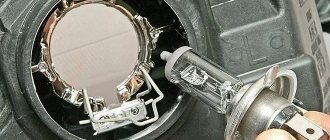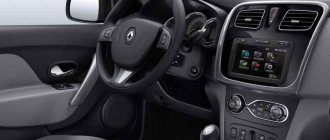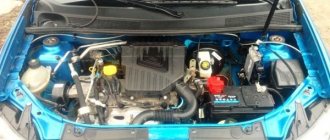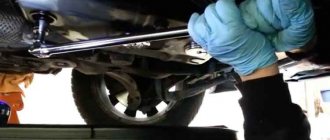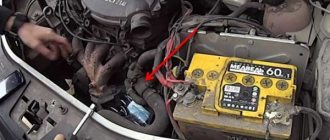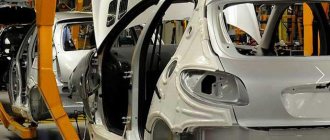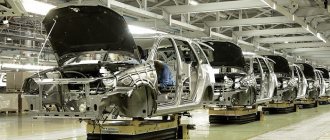Replacing the fuel pump
The first step in replacing a Renault Logan fuel pump is to remove the back row of seats. Dismantling begins with prying up either side of the seat. Next you just need to pull it up. The algorithm of actions is carried out on each side.
Removing the seats gives access to the top cover. The Renault Logan fuel pump is located under this cover. To remove the top cover, look for the arrow that points to the location of the fastening latch. You need to press and pry on it. Next, move the part to the side.
To prevent dirt and debris from getting into the fuel tank, you should thoroughly blow out the area where the fuel pump is located.
Now you can begin dismantling the cover and removing the pump. Use a sharp object to pry up the flag and pull it to the side, then remove the connector. After this, the next step is dismantling the hose. This part is secured with quick releases. They can be removed by squeezing on the sides.
The next stage of work is to unscrew the top plastic nut counterclockwise. This process is considered the most problematic, since you can only use a gas wrench or a homemade Renault Logan fuel pump puller. Unfortunately, there is not a single factory tool that is designed specifically for these purposes. To unscrew the nut, the gas wrench rests against the sides and turns counterclockwise
It is important in this work to put aside haste and abandon the idea of using a hammer and chisel. Using such a tool can deform the tank and reassembly will not work.
A rubber gasket is installed under the top cover of the pump. This part must be dried or wiped with a clean rag. Such actions will prevent the gasket from swelling from air.
When removing the pump, be aware that the float will make it difficult to remove. To remove the Renault Logan fuel pump, you need to pull it out with a slight slope.
We drain the remaining fuel through the valve. This is done by simply pressing on it.
To change the fuel pump or fuel pump screen, remove the bottom cover. It is secured with three latches located around the perimeter.
Pay attention to the presence of metal shavings in the remaining fuel in the cap. If there are chips, then the turbine needs to be replaced, since its service life is running out
Let's move on to removing the mesh. Even with slight contamination, the fuel pump mesh must be replaced.
Article number of the fine filter separately from the LF249M pump.
Let's start pulling out the pump itself. Slide the latch located on the case and remove the top cover. Now you need to remove the connector (just pull it off) from the fuel level sensor. Next, remove the fuel pump.
The fuel pump is secured with corrugation.
The factory-produced pump has different terminal width sizes. Therefore, the car owner will have to remake the negative terminal according to the corresponding dimensions of the positive one. To completely dismantle it, all that remains is to pull the fuel pump off the corrugation. To do this, everything is dried from residual fuel and the corrugation is heated with a hairdryer.
Once the old pump turbine is removed, it is possible to inspect and clean the fuel filter. Replacing the part is expensive because it comes complete with the body.
When installing a new pump, it is worth installing a clamp. This is done because the tube has already been crimped and will have some play. We insert the pump and tighten the clamp, which will hold it tightly and securely. Only this type of clamp should be used.
When the fuel pump has been repaired or the turbine has been replaced, we install the fuel pump at our workplace
It is important that the nipple looks straight. When assembling, the plastic nut is lubricated along the thread with any lubricant so that it does not bite
When reassembling, attention should be paid to putting on the gasket. This part is placed on the shoulder of the tank and pressed tightly with the lid.
When tightening the nut, it should be lubricated with any available lubricant. This will make the job easier.
Before installing the nut, you should check that the gasket is in place. Press the lid tightly, install the nut and tighten it. All that remains is to connect the connectors and install the fitting. We put back the back row of seats.
Removing the Renault Logan fuel pump is carried out extremely carefully, as there is a high risk of compromising the integrity of the plastic parts
Care should also be taken during reassembly. All elements of the system must be installed in place
Removing the fuel pump using Renault Fluence as an example
- Files
- Engine
Photo report of replacing the fuel pump using the example of Renault Fluence
The fuel pump on the Renault Megane/Fluence is located in the gas tank, access to it is through the cover in the rear of the cabin; to do this, you need to recline the rear seat.
The fuel pump is covered with a plastic cover and casing
To disconnect the connector on the fuel pump, you need to press the clamps on the side of the wires
The fuel wire is disconnected by pressing the green locking buttons on the connector
Next, you need to unscrew the cap that seals the fuel pump itself. At this stage, most unprepared owners, not just Renault Megane or Flunes, experience problems. The lid is a bit difficult to unscrew. Some owners “knock down” the cover with a hammer and screwdriver, but it is better to use universal fuel pump pullers or make a pump puller yourself.
Dimensions for making your own fuel pump puller. It is necessary to insulate a metal plate and adapt it to fit on a regular key.
View with cover removed
The pump is not simply pulled out upwards. Don't forget that the pump has a float.
We take out the fuel pump housing by tilting it towards the left door. Be careful with the rubber gasket - don't lose it.
After removal, wipe the rubber gasket with a clean rag to remove any remaining gasoline.
View of the removed fuel pump housing. The blue marker indicates the fuel gauge sensor mounts. Removed upwards.
If necessary, we replace or clean the fuel level sensor in Renault Megane/Fluence, etc.
Next, we assemble in reverse order, do not forget about the gasket.
Markers for correct installation of the pump are highlighted with a green marker. One mark is on the body, the other is on the gas tank.
photo: Victor, Fluence-club.ru
If you have anything to add to the article, or would like to share your experience on this topic, please leave a comment
If you are the author of a report on repairs, modifications of a Renault car, or recommend material for the Renault-Drive Knowledge Base, please let us know
Did you like the article? Support Renault-Drive: share with friends using the buttons below.
Diagnostics and repair of Renault Logan fuel pump: finding the source of the problem
Why is inspection and testing in our car service a mandatory procedure, without which repairs will not be carried out? Firstly, in all problems with engine operation, the culprit may not be the fuel pump at all, but elements of the fuel, electrical or ignition system. That is, its dismantling and repair in this case becomes impractical. Secondly, if the problem still comes from the pump, diagnostics allows you to determine exactly which element needs to be replaced or repaired. And this significantly reduces the work period. During diagnostics, the first step is to check and evaluate the overall performance of the engine, and identify problems with related systems. Thirdly, after the repair, the final diagnostics will make it clear that the work was carried out successfully. After dismantling the unit, the following are examined:
- Fuse (Renault Logan uses F02 (5 A));
- Relay;
- Mesh.
If these parts are in order, further repairs to the fuel pump are usually not worthwhile. In terms of the cost of other parts and work to replace them, it will be approximately equal to the cost of replacing the assembly. In addition, the new mechanism will last longer than the restored one.
Let's sum it up
As it turns out, you can diagnose the performance and partially repair the fuel system on a Renault Logan car yourself, since this is not such a difficult task. If at some point the engine stops starting, the most likely cause is a faulty relay or fuel pump. And the fuel pump needs to be replaced. After carefully reading this article, you will be able to carry out the diagnostic and repair work indicated here on your Renault Logan car.
About the features of the system design
The design of the fuel supply system to the Renault Logan engine implies the presence of several components through which the fuel-air mixture under pressure enters the combustion chambers of the cylinders. The main elements of this system are:
- gas tank;
- main fuel line;
- fuel rail;
- return line;
- nozzles;
- pressure regulator;
- fuel gasoline pump;
- level sensor and filter.
Sometimes the fuel pump needs to be replaced. The functioning of the system under consideration is subordinated to an on-board computer, which, in real time, based on signals from various sensors, adjusts the operation in order to ensure that the mixture is supplied to the combustion chambers with an optimal ratio of fuel and air. If one of the components malfunctions, the on-board controller generates an error on Renault Logan. And in this case, a mandatory replacement of the fuel pump is required, and in this case you need to know Renault Logan how to properly remove the broken element.
A special electric relay is responsible for the timely and correct supply of supply voltage to the fuel pump and to the elements. Without going into the technical aspects of the system, we will try to understand and clearly describe the process.
- When the ignition key is turned to the 2nd position, the fuel pump relay is turned on, which operates for several seconds, providing the required pressure in the fuel rail. The engine can then be started. This is the normal operating mode of the system.
- When the Renault Logan engine starts, the relay is activated again, ensuring that the pump operates continuously throughout the entire engine operation. Thanks to this, fuel is supplied to the ramp continuously through the fuel pump. In it, the regulator ensures that constant fuel pressure is maintained, eliminating the formation of excess (it returns to the tank via the return line).
- If interruptions occur in the operation of the motor, the first diagnostic measure will be to check the integrity of the pump fuse and relay. And if a breakdown is detected, the fuel pump needs to be replaced.
How to remove the fuel pump on a Renault Logan with your own hands (+ video)
Sooner or later, every detail comes to an end. This is due to irreversible wear and tear. So, if there is no supply of gasoline to the combustion chambers, most likely the fuel pump has failed. But not every Renault Logan owner knows how to dismantle it. There is nothing complicated about this process and it can be done in your garage.
| TOP 15 most useful products for Renault Logan - OUR EXPERIENCE! |
- 1 Removing and replacing the fuel pump on Renault Logan 1.1 Video of replacing the fuel pump on Logan
- 1.2 Fuel pump diagnostics
Removing and replacing the fuel pump for Renault Logan
Since the fuel pump is located in the fuel tank itself, and it is located under the rear seat, you will have to remove the rear sofa. If the sound insulation is pasted over, along with the hole for access to the fuel pump, then it will have to be cut out. Of course, not all of it, but only a part that interferes with normal access.
Now let's look at the dismantling process itself:
- Disconnect the power supply wires to the fuel pump from the connectors.
You will have to tinker with the lock, as an option, an oil filter puller
We combine the arrows on the fuel pump and on the body
So, dismantling the fuel pump on a Renault Logan is quite simple and easy with a minimum set of tools.
Video of replacing the fuel pump on Logan
Fuel pump diagnostics
In order not to make a mistake when buying a new part, you should be sure that it is the fuel pump that is not working. To do this, you will have to carry out a number of diagnostic operations. So let's get started:
- The first diagnostic operation will be to simply turn on the ignition switch. If you turn the key to position No. 2, the fuel pump will create a certain sound that will be heard. If he didn’t appear, then that’s definitely the reason.
- The next step is to examine fuses and relays. Examine the fuse (F02 (5 A)), which is responsible for the operation of the fuel pump, and determine its functionality. Change if necessary.
Location of fuses in the main unit
conclusions
It is worth noting that removing the Renault Logan fuel pump should be carried out quite carefully so as not to damage the plastic parts. When replacing internal elements, you need to be extremely careful to install everything correctly. The performance of the Renault Logan fuel pump will depend on this.
Fuel pump diagnostics
You can detect a breakdown in the following ways:
- turn on the ignition and turn the key to position 2 - there should be a characteristic sound;
- inspect the fuse responsible for the operation of the module - it should not have any signs of soot or wear;
- turn on the ignition several times, listen to the operation of the relay - a characteristic click should be heard.
Experts also recommend measuring the pressure in the fuel rail using a ready-made or home-made measuring device (a tube from an old filter, a piece of hose and a pressure gauge). The indicators should not differ greatly from the recommended 0.35 MPa. It is advisable to do the check sequentially and several times - you need to:
- connect the pressure gauge to the ramp;
- start the engine;
- measure pressure;
- rev up the gas, measure again;
- turn off the engine;
- After 2 hours, repeat the measurement procedure again.
Please note: if there is a gradual drop in pressure, this indicates a breakdown of the fuel pump.
We change the fuel filter
The operations for changing the fuel filter part in different modifications of Renault Logan differ significantly. To change the filter element in a second-generation car, you must replace the entire fuel module, that is, both the filter and the fuel pump.
What is needed for replacement:
- the presence of an inspection hole or overpass;
- screwdrivers;
- puller;
- a set of keys;
- fuel container;
- new filter or fuel module;
- soft clean cloth;
- WD-40 and a metal brush.
According to the manufacturer’s recommendations, it is better to purchase an original filter part, since there will be no unnecessary problems when installing it. An alternative is filters from German, Polish and Czech manufacturers.
Before changing the filter or fuel module, it is necessary to relieve the pressure in the vehicle's fuel system. Note that it will last about three to four hours after stopping the engine.
To relieve pressure, carry out the following actions:
- Raise the hood;
- Disconnect the negative terminal;
- By pressing the locking elements, remove the block cover, which is located near the battery, and remove the fuel pump relay;
- We connect the terminal in its place;
- We start the car engine (after some time it will stall);
- Turn off the ignition and remove the negative terminal.
Renault Logan fuel pump replacement
Replacing a Renault Logan fuel pump requires at least a minimum set of tools:
- screwdrivers with flat and Phillips blades;
- Torx keys;
- voltage test controller or multimeter.
If the procedure is carried out earlier than 3 hours after stopping the engine, it is imperative to relieve the pressure in the power system. You need to do it like this:
- raise the back seat of the car;
- pry off the fuel module cover with a screwdriver and lift the hatch;
- relieve pressure in the rail by disconnecting the corresponding hose from the fuel module cover connector;
- start the engine, let it run in XX mode until it stops;
- turn on the starter for 3 seconds;
- disconnect the negative terminal of the battery.
The next steps are:
- disconnect all hoses (fuel supply, drain) from the terminals of the module cover;
- throw a special puller or a homemade device (made from a 10 mm metal rod in the form of a bracket) onto the pressure ring;
- insert the bracket, start rotating the ring counterclockwise;
- remove the ring and then the pump.
Remove the fuel module with extreme caution! At the bottom there is a fuel level regulator, which can be damaged when removing the fuel pump. After removing the part you need:
- drain the remaining fuel from the pump into a container;
- remove the sealing collar;
- Cover the hole in the tank with polyethylene or thick paper.
Now we carry out a more thorough inspection of the pump, because in some cases replacement is not necessary. For example, if only the mesh or sensor is damaged, it is enough to carry out competent repairs. To find out, disassemble the module. Here's how it's done:
- the fuel level regulator wiring block, located on the inside of the cover, is disconnected;
- the wires are removed from the holder on the pump body;
- the sensor is carefully moved upward along the guides with tweezers and removed;
- the upper part of the pump is dismantled (just squeeze 2 side latches);
- the valve in the fuel module housing is inspected.
The rear valve prevents fuel from leaking out. It may be damaged, fuel periodically leaks, the pump does not work normally. Therefore, it needs to be thoroughly checked. The check must be carried out using the following algorithm:
- Pull off the sealing gland and support washer from the sensor tube;
- pull out the spring;
- remove the regulator tube from the socket by squeezing the desired lock with a screwdriver;
- disconnect the sensor wire connecting it to the pump;
- halve the upper part of the fuel module by squeezing the lock with a screwdriver;
- pry it with a tool and remove the mesh from the fitting.
If it is very clogged, it must be changed and a new mesh filter installed. If the pump itself breaks down, it is necessary to continue disassembling:
- use your fingers to squeeze both upper side latches;
- remove the pump from the holder;
- disconnect the wiring - black and red cables;
- pull out the plastic corrugation from the pump nozzle, after heating it over a container of hot water.
After this, the removal and disassembly of the fuel module can be considered complete. Installation is carried out in the reverse order - a new element is installed, the module is assembled. Remember that when installing, the arrow on the pump cover must point to the tank mark. You can learn more about how to replace an element from the video:
Fans of the Renault Logan model should refer to this article if interruptions in operation have begun to occur in the fuel system of their car’s engine. Here we will look at most of the aspects that determine the stable operation of the power unit and give advice on how to diagnose the fuel pump yourself. Implying that most car enthusiasts find it difficult to correctly identify the location of the fuel pump, much less understand the principles of its operation and diagnostic methods, we believe that this material is undoubtedly relevant for this category of people.
We’ll also figure out how to replace the fuel pump. And how to properly remove the unit so that the fuel pump can be replaced.
Renault Logan 1.6 Blue Diamond › Logbook › Replacing the fuel pump
Even from the moment I bought the car, I noticed that when driving for a long time on the highway at high speed, traction periodically disappeared, the gas pedal did not respond to pressure and the engine stalled while driving. This didn't happen often, but it was very unpleasant. Then I still didn’t know what was going on and wasn’t particularly worried, but everything got worse sharply...
With the move to Yaroslavl, my driving style changed. Long drives around the city in the heat and with traffic jams aggravated the problems with the fuel pump. It turned out that the fuel pump motor overheated during such operation and could no longer maintain the required pressure in the system.
When I finally got tired of everything, I decided to go to the service center for diagnostics. I went to the wonderful guys from RENAULT SERVICE, located on Leningradsky Prospekt, 25A. It’s worth saying right away that the guys know their business, the service is top-notch, diagnostics are free, and they even provide a 60-day guarantee. They do everything quickly and conscientiously.
We started with an external examination and computer diagnostics, but this did not bring any results. We decided to look towards the fuel pump, namely the pressure in the fuel system. In the next box they attached a cunning device for measuring pressure and started the engine. Normal blood pressure should be 3.1-3.5, but mine was already 2.8. We waited ten minutes and the pressure dropped to 1.5, the car stalled. Conclusion: the fuel pump motor is overheating and needs to be replaced.
A new ERA fuel pump (analogue) was purchased as a replacement. Price: 3850 rub. I arrived at the service guys at the appointed time and nothing seemed to indicate trouble. It would seem like only about twenty minutes of work, but how wrong we were... We pulled off the back seat, opened the fuel pump cover, relieved the pressure, disconnected the wires and began to unscrew the plastic ring securing the fuel pump with a special puller. This is where the problems started. The ring was so stiff and stuck that it was impossible to unscrew it.
We made the bitter decision to carefully break the ring with a dull chisel and buy a new one. Price: 1750 rub. It took about half an hour to carefully break out the plastic piece by piece with a chisel and hammer so as not to damage the gas tank. In the meantime, a new ring was delivered. The old one was dismantled for scrap.
We pulled out the old fuel pump and discovered a problem with the motor overheating. It’s not clear where or why, but a layer of rusty plaque has formed on it. The service guys said that they had never seen anything like this before, although they have quite a lot of experience in replacing fuel pumps.
With the new plastic ring, things didn't go quite smoothly either. It turned out that the thread was cast poorly and did not match the original ring. I had to spend another hour manually turning the thread to the required parameters. To do this, they used improvised tools, from a knife to a screwdriver. When buying a new ring, I advise you to take your old one with you and carefully compare the threads.
After all the simple manipulations, we were finally able to install the new fuel pump and secure it securely. I think that next time it will not be possible to remove the plastic ring without deformation, because... the village is even denser than the original one.
Overall, I was pleased with the renovation, even though it took a while. The guys are masters of their craft, they did not give up in an unusual situation and did everything conscientiously. In addition, they gave a 60-day guarantee on the work, during which I can apply for free correction of defects. There are sea trials ahead, but I think everything will be fine now.
Signs that a Renault Logan fuel pump needs to be replaced
Failure to carry out this procedure in a timely manner can affect not only driving comfort, but also the condition of the engine and many vehicle systems. There is no need to talk about safety, taking into account the fact that the driver may get into an accident if the engine stalls on a busy highway.
So you should pay attention to the slightest signs of fuel pump failure. Among these are:
- A gradual decrease in engine power (for example, the car may not “pull” on inclines);
- Its possible shutdowns while driving;
- Reduced fuel pressure;
- Difficulties when starting the engine (it does not start on the first try);
- Incorrect operation of the engine (troits, runs jerkily, gives “dips” at idle);
- More fuel is wasted;
- A humming sound is heard from the pump.
GOOD TO KNOW.
Signs of a fuel pump malfunction usually appear complexly, but as they increase. That is, at first the hum may be barely perceptible, and gasoline consumption is unnoticeable; the driver begins to judge problems by the behavior of the engine. It is recommended to undergo diagnostics for preventive purposes, without waiting until the symptoms manifest themselves fully and the situation worsens.
Which fuel pump is suitable for Renault Megane 2
Typically, this is a DIY project that you will have to borrow or buy. Often this stripper is neglected and traditional methods are used, pressing the plastic pressure plate with a chisel or a powerful screwdriver. This procedure, without the use of a stripper, can cause the rim to rupture or the teeth to break, requiring replacement.
After removing the gasoline pump clamp nut, pay attention to the gasket. If there are no visible defects, the clamp can be used. Now you can get the entire pump assembly. The assembly contains a fuel level fuel pump from a VAZ to a Renault with a float, so when removing the structure from the gas tank, turn it slightly to the side so as not to deform the float rod.
At the bottom of the device there is a special inlet valve, to which a finger is pressed, holding the pump structure in the hands over the opening of the gas tank, and fuel is discharged from the cup. Before removing the bottom cup, mark it with a marker to ensure it is in the same place when tightening. This is important for positioning the float.
You can then remove the bottom housing. Pre-fuel pump from VAZ to Renault. It must not be tampered with, otherwise it will become a source of fuel leakage.
It's easy to remove the cup. To do this, you need to lightly tap the edge with a hammer and it will come out of the hook. Do not hit the stiffeners on the side of the fuel level sensor. The filter grid is now available. The fuel pump from a Renault VAZ is located at the very bottom of the structure and must be cleaned.
Even if the problem is not the fuel pump from the VAZ to the Renault filter, cleaning it will never hurt. In a car with decent mileage, the filter may look like black soil before planting the potatoes and it should glow. We are changing the timing belt on a Renault Symbol 1.4 with a K4J 16V engine. It was a sunny February morning, the firewood was quietly clicking in the stove, the kettle was boiling and, as if nothing promised failure, how it appeared: The same pump, supplied in quantities of tens to hundreds of pieces offered to us for several thousand.
Information, as you know, costs money, which is why dealers try in every possible way not to answer questions about the interchangeability and compatibility of parts with other brands and models of cars.
Replacing the Renault Logan fuel pump mesh
Among the elements of this unit that most often require maintenance, craftsmen highlight the filter (or mesh) of the fuel pump. Usually its condition causes alarm before anyone else, after about 20-30 thousand kilometers, and this is not surprising, because the mesh is the first element of protecting the entire system from clogging.
After inspecting it, the technician makes a verdict - it needs to be replaced (if there is damage) or you can simply clean it (if it is just clogged). The cost of the mesh is not significant, so there is no question of any significant savings for the client. In any case, replacing the Renault Logan fuel pump grid begins with dismantling. It is carried out according to the same scheme as replacing the entire pump assembly. Next, when the pump is removed from the car:
- The housing is being cleaned.
- The float is removed.
- Sensors and wires are disconnected.
- The latches in the pump come loose.
- The mesh is removed.
If the mesh is in good condition, but very dirty, clean it by soaking it in a reagent, washing it with a cleaner and blowing it with a compressor.
The dangers of untimely replacement of the fuel pump
The fuel pump ensures an uninterrupted and timely supply of fuel necessary for the operation of the car. If you ignore the signs and timing of replacement, the pump will gradually cease to perform its functions. As a result, the car will not be able to start.
It is best to carry out replacement according to a schedule or when the first signals of a fuel pump malfunction appear. A car can continue to drive for some time on a faulty fuel pump, but sooner or later the unit will burn out, which usually happens at the most inopportune moment.
How to replace a fuel pump?
The fuel pump is replaced as follows. Before starting work in the cabin, we dismantle the sofa in the rear row of seats. To do this, take the lower edge of the Renault Logan seat with your hand and sharply pull it up. The latches open and the sofa disengages from the body.
- We free the pump location from the carpet insulating covering of the bottom and disconnect the electrical connector and fuel pipes from the upper pump module.
- Using a chisel (dull) and a hammer, unscrew the plastic ring retainer holding the assembly.
- We take out the pump assembly with the fuel sensor and place it on a previously prepared surface.
- Using the required tools, we disassemble the assembly and remove the pump itself from it.
- We install the new fuel pump into the existing housing. Also, don’t forget about installing the filter.
- We carry out the procedure for installing the fuel assembly into a seat in the Renault Logan gas tank in the reverse order of the dismantling process.
- We tighten the clamp, connect the fuel hoses and connect the power connector.
The fuel pump replacement is complete. We check the functionality of the system by turning on the ignition a certain number and starting the Renault Logan engine. If the engine is working properly, then the defect has been successfully eliminated on your own.
Pump replacement
To begin work, we need to dismantle the rear sofa, since the part we need is located right under it. To do this, you need to grab the bottom edge of the seat and pull it up sharply. The latches will be released, and you can easily dismantle the required part.
- Having cleared the working area from the carpet, we need to disconnect the electrical connector of the pump and its tube.
- Using a blunt chisel and hammer, unscrew the plastic fuel assembly retainer.
- We take out the entire assembly of the pump and fuel level sensor, placing it on a previously prepared table.
- Using a tool, we disassemble the housing and take out the pump.
- Having prepared the new part, we install it in the old housing, not forgetting to install the filter.
We carry out the rest of the assembly and installation in reverse order, not forgetting to connect the electrical connector.
Check your operation by turning the ignition on and starting the engine several times. If your Logan’s engine is working properly, then we have successfully solved the problem on our own.
The work of diagnosing and replacing the fuel pump on a Renault Logan car can be considered successfully completed.
What signs indicate the need for replacement?
The fuel pump may need to be replaced much earlier than scheduled. The service life of the fuel pump is influenced by the quality of the gasoline being poured and errors during vehicle operation. To prevent early failure of the device and its unscheduled replacement, you must follow simple rules.
- Get rid of the habit of refueling your car when the tank is almost empty. The design of the pump on Renault Logan is designed in such a way that the system is cooled by circulating fuel. If there is too little of it, pump parts operate at elevated temperatures, wear out faster and fail.
- Check the serviceability of the electrical system in the car. Interruptions in the operation of the system lead to voltage drops. Due to such a jump, the fuel pump instantly fails.
- Install only those fuses recommended by the manufacturer. This will help protect the pump from the risk of damage due to power surges. In addition, a poor-quality fuse can cause interruptions in operation and failure of the pump.
- Make sure the relay is in good condition. Due to relay failures, the fuel pump also often fails.
- Change filters in a timely manner.
- If possible, fill the car only with high-quality gasoline and avoid increased loads on the engine.
Problems with the fuel pump are indicated by changes in the operation of the vehicle. They are not difficult to notice during operation. The need for diagnostics is indicated by:
- reduction in engine power;
- the appearance of difficulties when climbing (the car “does not pull”);
- the car does not start on the first try or does not start at all;
- the motor stops working during short stops or during movement;
- fuel pressure is below the established norm;
- the engine “troubles” or runs jerkily;
- “dips” are observed at idle, the engine runs unevenly;
- fuel consumption increases for no apparent reason;
- During operation, an extraneous sound (humming) is heard in the area where the pump is located.
If you have doubts about the serviceability of the pump, you can carry out diagnostics yourself. It won't require much time or effort.
To check the operation of the fuel pump, you need to set the ignition key to the second position. If there are no malfunctions, the pump will make a characteristic buzzing sound. The absence of sound indicates a breakdown in the power supply circuit or the pump itself.
To diagnose the supply circuit, it is necessary to open the relay block and check the integrity of the fuse contact.
To check the functionality of the relay, you will need an assistant. While he turns the ignition on/off several times in a row, the driver listens to the sound made by the relay. A click should be clearly audible, the absence of which indicates a malfunction in the operation of this device.
If, after diagnostics, it was not possible to find a breakdown in any of the specified elements, and signs of malfunction persist, there is a malfunction of the pump itself.
Replacing the fuel filter on Renault Logan
Carefree operation of a vehicle is impossible without periodic maintenance. One of the items on the list of work during the next maintenance is replacing the fuel filter. It is an integral part of the car’s fuel system and its task is to protect the engine from dirt and rust. Let's take a closer look at when and how to replace the fuel filter on a Renault Logan with a gasoline engine.
Typical causes of breakdowns
Sooner or later, the fuel module, like other components of the machine, becomes unusable. This is due to banal aging and wear of device parts. However, you should be aware of the reasons that cause premature failures:
- Driving with a half-empty tank negatively affects the operation of the fuel supply element. On the Renault Logan, the fuel cell is cooled by gasoline. If the fuel level is insufficient, the fuel pump heats up faster and wears out.
- Untimely checking of the electronic part of the module also causes a reduction in the resource of the unit. Damage to the wiring leads to voltage surges and short circuits - this is why the part burns out.
- Use of low quality gasoline. You should try to refuel with high-quality fuel, even if it costs more - there are many good gas stations in Moscow. Instant savings on fuel lead to quick repairs of the unit.
- Lack of filter maintenance is another reason for rapid wear. The fuel pressure decreases, the device experiences increased loads.
Prevention options
In order not to constantly purchase a large number of fuses, you need to apply preventive measures.
- The most common way to avoid frequent failure of fuses is to replace them with a more powerful element. Experts recommend installing the device at at least 15 amperes. In this case, the likelihood of problems occurring and fuses blowing is reduced significantly.
- Secondly, you need to carefully select devices, since the electrical power is indicated on the packaging of DVRs, car radios and other products used in cars. To avoid blowing fuses, you need to carefully read their technical characteristics and only then connect them to the car’s electrical network.
- The third condition is that it is recommended to connect the plug correctly. Since due to a mismatch between the standards of the plug and socket of the device, certain problems may arise. The plug is connected correctly if the contacts are in a horizontal position, i.e. on the sides (not below and not above!). This arrangement will avoid burnout and melting of the terminals.
But if a problem does arise and the element burns out, then it will have to be replaced with a new one. This procedure is extremely simple; in Renault Logan you can get it out by prying it off with a thin flat-head screwdriver.
Find out more about the new Logan
- Renault cars - where is the cigarette lighter fuse, fuse box under the hood
- Renault Logan fuse diagram 1 and 2, replacing fuses in the cabin and under the hood
- Renault cars - where is the cigarette lighter fuse, fuse box under the hood
- Logan fuse box
- Vibration at idle Renault Logan, what to do?
- Renault cars - where is the cigarette lighter fuse, fuse box under the hood
- Renault Logan box capacity
- How much does tuning Renault Logan cost?
Location of fuses and relays Renault Logan
If the headlights stop shining on high beams in the appropriate mode, check the lamps, steering column switch with connector and wiring. F13 30 A - rear electric windows. F14 30 A - front electric windows. F15 10 A - ABS.
F16 15 A - Heated front seats. If the front seats stop heating when the heating is turned on, check the connectors under the seats and the connections in.
Test them for 12 V voltage and apply voltage to check the serviceability of the heating elements. If the elements do not heat, disassemble the seat and inspect it. If you have a Renault Logan fuel pump fuse where the fuse is located, before you determine the cause of its damage, the new fuse will also blow.
Sometimes a fuse may blow or cause an electrical circuit to open for no apparent reason. Corrosion of the fuse and fuse block terminals can cause damage to the fuse contacts.
If this occurs, remove any traces of corrosion using a wire brush or sandpaper, then spray the fuse terminals with electrical contact cleaner. Fuses, their numbers and assignments located in the passenger compartment Most fuses are installed in the Renault Logan fuel pump fuse where the fuse box is located in the passenger compartment; the block cover in the instrument panel has been removed, located at the left end of the instrument panel under a plastic cover.
Very often it is because of this that the fuel pump does not work. If I'm not mistaken the wire is green.
Fuses and relays of mounting blocks Renault Logan 1.4
I also heard that a lot of moisture accumulates there. Check it. And then check the relay.
What does this have to do with injectors? I removed the hose. The fuel pump and turned the starter, gasoline does not flow, I want to change the relay and check, if the fuel pump fuse does not work, that’s why I ask what the relay looks like, I know that it is located in the block near the battery, but where is the Renault Logan fuel pump fuse located? looks like?
To check, you can wave with another, there are only two types of them - large and small.
The originals cost rubles, but tens of rubles are quite suitable. Take the fog light relay and stick the fuel pump relay in place. If the fuse is blown, then you will have to look for the cause of the failure, and if it is intact, then we check the relay.

